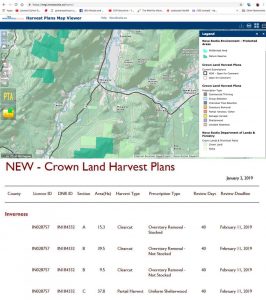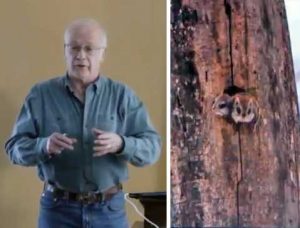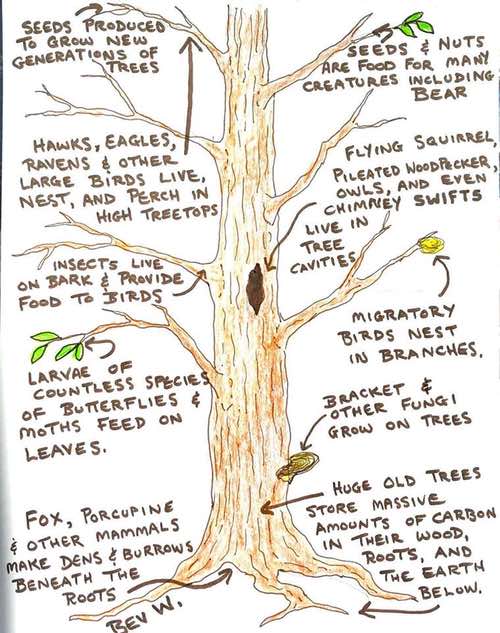
No records of the [apparently] approved harvests (below) remain on the HPMV (above; viewed Mar 10, 2019). The table below is from a notification sent out to subscribers of “map-update notifications”, and might allow one to locate the pieces in question but I could not find any other maps showing locations of the DNR IDs cited in the table.
HD: I am not one to write on this site but today I have to describe an event that saddened and angered me. On a trip north through the Margaree Valley this evening we met a logging truck. It was right around 5pm, a time when most people would not have seen it as they would be home with their families having supper.
To my utter disbelief the truck was loaded with some of the last Nova Scotia Giant trees. Freshly cut the diameters of these trees appeared no less than 24 inches with many appearing up to 30 inches. The truck was full to the top and could not hold more than 10- 15 logs.
I do not know where these trees were coming from, but I do know there were 3 parcels of crown land in behind Margaree Forks that had been posted in the NS Harvesting map that were open for comment until mid-February.
As noticed on this site, many sites open for comment are harvested just days after comment dates close. My first inclination is that this is the source of these once majestic trees.
Whether this was slated for a clear cut, partial harvest or shelterwood cut or whatever they want to call it, these trees should not have been harvested at all.
Mr. Rankin, I hope you are reading this. This area is well known for the Flying Squirrel with recorded sightings as of last fall. They need old growth forest to survive. Mr. Bancroft, if you are reading this, I have more evidence for your case if you need it. I will be happy to talk with you.
——-
Whatever the truth of the matter – whether the logs came from those Crown land pieces or not – the story reflects a sad reality in Nova Scotia today: we are squandering the last of the best we have and with it, we are consciously contributing to precipitous local and global declines in biodiversity, and reducing carbon stores in forests when we most need them.
Because Forestry Maps/L&F removes records of Crown land harvests from the HPMV once approved (although promising now to retain to retain some for some period, all rather vague at the moment) and provides no notification about when harvesting begins and is completed on particular pieces approved for harvest – it is hard to begin to try to follow up on HDs comments.
But Forestry Maps/L&F know the answer, so Mr. Rankin/L&F, please help us: Has harvesting begun on those parcels referred to by HD?
And if you wouldn’t mind, whether or not harvesting has begun on those pieces, please repost the locations… there are Nova Scotians who still want to see and experience what we still have or do not still have in our Crown land forests.
Thanks
———————–
And an early graphic/comment:
Bev Wigney: DIAGRAM OF A MATURE TREE
On Annapolis Royal & Area – Environment & Ecology, Mar 10, 2019
“….For The Edification of Those at Department of Lands & Forestry Who Do Not Yet Understand The Value of a Mature Tree.
“My comment in reference to a post on The Healthy Forest Coalition regarding mature “giant” trees being hauled out of Margaree Forks this weekend:
“We’re all becoming just sick — heart sick — of seeing these great old super canopy trees hacked down — when they should be left standing to provide nest cavities for Flying Squirrels, Pileated Woodpeckers, Owls, and even Chimney Swifts! Their lower branches provide nesting sites for migratory songbirds, and their highest branches provide roosts and nesting sites for Ravens, Hawks and Eagles. Sheltered among their roots, Fox, Porcupine and other mammals make their burrows and dens. They host colonies of fungi, and their leaves feed the larvae of countless species of moths and butterflies. Their bark feeds or provides habitat for other insects which are then food to birds. They produce seed for generations of trees to come. Many produce nuts to feed many creatures including Bear. They store carbon in their wood and in their roots and the ground beneath. They give shade and help to moderate climate. Long after they begin to die, they are still filled with life. The trunks continue to provide shelter for many creatures. When they finally fall to the earth, they become nurse trees for mosses, ferns, lichen, fungi, while saplings of the next generation take root in their decaying mass as it returns to the earth from which it grew. Tell me how a tree that provides so much to the biodiversity of a forest is worth nothing more than two or three hundred bucks and be carted off to be burnt in a biomass plant here in Nova Scotia, or chipped and shipped off to fuel a power plant in Europe or the UK. No, these trees are the “real gold” in our forests when left in place for our children and grandchildren — and not to be sold off like worthless debris.”
More Comments (some)
SKG: Driving home from Halifax to New Glasgow last Tuesday, March 5th around 11:00am near Milford, we saw three trucks with these huge logs heading towards Halifax, so they weren’t going to Northern Pulp or Port Hawkesbury for biomass. We had wondered where they were coming from and what the end purpose would be for the logs. It also saddened us that big giants were cut for whatever reason!
CS: This is a very unfortunate but common siting here in Annapolis valley and south west NS. We have seen it constantly for the last 10 years in our area but the evidence of the cuts are everywhere. It also doesn’t seem to matter which wildlife are being displaced and their habitat destroyed. I truly hope the lawsuit will help but time is not on our side with these matters.
CS: I see this kind of thing quite a bit. The general feeling among Nova Scotians is that if such forests are cut from private land, it’s nobody’s business. A backward approach to ecology since the ecology could not care less where the forests are located.
DC: This is the elephant in the room as land-owners in NS have the best of all capitalist worlds when it comes to forests. The forest land enjoys a very low tax-rate and its use/misuse is totally unregulated. Therefore land-owners are reluctant to hold Crown Lands/L&F to a high standard as that would perhaps (IMO, would & should) lead to questions about how private lands are treated. That private forest land must remain unregulated is a myth. Time to bust that myth!
CS: My thought on it is trees are a common resource, just as game. Just as landowners cannot shoot any wild game on their land, they should not be allowed to arbitrarily destroy precious old forests. And it can be made worth it to them to do so. They could receive carbon credits for maintaining their forests, which could then be sold. As one of many options.
SL: On a trip to Cape Breton in late December from Hammonds Plains to Truro, I counted seven huge, heavily filled forestry trucks on the highway. It sickened me. Perhaps driving the filled forestry trucks at less busy times, is another way to try to keep Nova Scotians ignorant of the destruction that is taking place all around us.
AI: The headwaters of the Margaree River have been clear cut for some time. It was heartbreaking the last time I was up there.
(So far, no comments defending the cuts of Big Trees)


